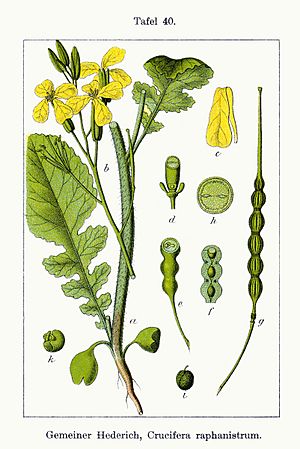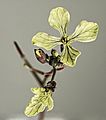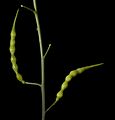Wild radish facts for kids
Quick facts for kids Wild radish |
|
|---|---|
 |
|
| Scientific classification | |
| Genus: |
Raphanus
|
| Species: |
raphanistrum
|
Raphanus raphanistrum, also known as wild radish, is a flowering plant that belongs to the Brassicaceae family. This family also includes plants like cabbage and mustard. One type of wild radish, Raphanus raphanistrum subsp. sativus, is actually the common radish we eat!
Wild radish originally comes from western Asia, Europe, and parts of North Africa. However, it has been moved to many other places around the world. In some areas, like Australia, it grows very fast and can take over habitats. This makes it an invasive species. You often see it growing along roadsides or in places where the ground has been disturbed.
Contents
What Does Wild Radish Look Like?
Wild radish is an annual plant, meaning it lives for only one year. It can grow up to 75 cm (about 2.5 feet) tall. Its stems are green, sometimes purple near the bottom. They are round and have small ridges, covered in bristly hairs.
Roots and Leaves
The plant has a thin taproot that goes deep into the ground. This root does not get big and round like the radish you eat.
At the bottom of the plant, there's a group of leaves called a basal rosette. These leaves can be up to 38 cm (about 15 inches) long. They have a main stalk and several smaller parts, making them look like a feather (pinnate leaves). The top part of the leaf is large and rounded with wavy edges. As the leaves go up the stem, they become less divided. All the leaves are rough and hairy.
Flowers and Fruits
Wild radish flowers usually bloom from May to October in northern Europe. The flowers grow in a loose cluster called a raceme. Each cluster can be up to 34 cm long and hold many flowers.
The flowers have four petals. These petals are usually white, but can sometimes be yellow or purple. They often have dark veins, especially on the underside. There are also four green or purple sepals, which are smaller than the petals. Each flower has six stamens (the parts that make pollen) and one style with two stigmas (the parts that receive pollen).
After the flowers, the plant grows fruits. These fruits are pods that hang vertically. Each pod has two parts. The upper part can be up to 8 cm (about 3 inches) long and holds 1 to 10 seeds. The seeds are oval and up to 3 mm long. The pods can be smooth or slightly ridged and have a peppery taste.
How Wild Radish Was Named
The famous Swedish botanist Carl Linnaeus officially described wild radish in 1753. He wrote about it in his important book called 'Species Plantarum'.
Types of Wild Radish
There are a few known types (subspecies) of Raphanus raphanistrum:
- Raphanus raphanistrum subsp. landra (also called 'sea radish')
- Raphanus raphanistrum subsp. rostratus
- Raphanus raphanistrum subsp. sativus (this is the common radish we eat!)
Wild radish has many common names, like jointed charlock, white charlock, and jointed wild radish. People sometimes mistake it for mustard.
Where Does Wild Radish Grow?
Wild radish is native to warmer parts of North Africa, Europe, and some areas of Western Asia.
It can be found in many countries. In North Africa, it grows in places like Algeria and Morocco. In Western Asia, you can find it in countries such as Iran and Turkey. It also grows across Europe, from Denmark in the north to Italy in the south.
Wild Radish in Nature
This plant can handle cold weather. Even very hard freezes only stop its flowering for a short time. In Australia, it is seen as an invasive species because it can harm local habitats.
In Canada, wild radish has become a naturalised species. This means it grows there even though it's not originally from that area. It can sometimes even mix its genes with cultivated radishes. Some types of wild radish have also become resistant to certain herbicides, which are chemicals used to kill plants.
Wild Radish and Pollinators
In the southeastern USA, the pale yellow type of wild radish is very common. It provides a lot of pollen and nectar for many pollinators. Honey bees especially like it in early spring. Other insects, like Andrena agilissima (mining bees), cabbage butterflies, and some syrphid flies, also visit wild radish for food.
Uses of Wild Radish
Almost all the soft parts of the wild radish plant can be eaten. The leaves and flowers have a spicy taste. You can also eat the seedpods and the outer skin of the root after washing it.
Long ago, in 1753, a natural historian named John Walker grew sea radish root. He used it as a substitute for horseradish after finding the plant on the coast of Scotland.
Gallery
See also
 In Spanish: Rabaniza para niños
In Spanish: Rabaniza para niños






